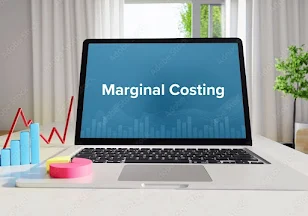What is Marginal Costing ?
The term 'marginal cost' is derived from an important economic concept of 'margin'. However, economic concept of 'margin' is different from accounting concept. As an economic concept, marginal cost is the expenses incurred for producing an additional unit of a product, while accounting concept of margin cost implies the total cost by aggregating prime cost and variable cost. Thus, it includes all costs except fixed cost.
Marginal costing is not a costing method like process costing or job costing. It is a distinct technique and is primarily used for the purpose of managerial decision-making. Marginal costing may be used for measuring the profitability of various product lines or cost centres. This technique is helpful in bifurcating costs into distinct categories such as "variable costs" and "fixed costs". Variable cost constitutes marginal cost of the product.
Definition of Marginal Costing
The Institute of Cost and Management Accountants, London, has defined Marginal Costing as :
"The ascertainment of variable costs and of the effect on profit of changes in volume or type of output by differentiating between fixed costs and variable costs".
'Variable Costing' is another term used for Marginal Costing. It denotes the amount by which total cost change when there is an increase or decrease in the production volume by one unit. It equates to the total variable cost of a unit.
Features of Marginal Costing
Marginal costing has following main features :
- This technique is used for analyzing and presenting costs to the management for helping in decision making. It is not a separate costing technique like job costing or process costing.
- It classifies all elements of cost into fixed and variable categories. Semi-variable costs are also bifurcated into fixed and variable categories.
- The variable component of the total cost is considered to be the marginal cost of the product.
- Contribution margin is used for determining the profitability of products and cost centres.
- Variable cost is used for valuing closing stock.
Advantages of Marginal Costing
Following are the main advantages of marginal costing :
1) Simple to Use and Understand :
Marginal costing technique is simple and convenient to use. Since this technique excludes fixed costs and uses only variable costs, the cost statements are easy to understand and implement.
2) Avoids Under-Absorption of Overheads :
This technique does not use the process of allocation, absorption or apportionment of fixed costs and thus reduces the issues related to under-absorption of fixed cost.
3) No Over-Valuation of Stacks :
Marginal costing does not carry forward fixed costs in the form of inventory valuation and thus avoids the possibility of over-inflating profit by inflated closing stock valuation.
4) Helps to Management :
Marginal costing helps the management in taking, key decisions. These decisions may relate to shut down, designing of optimal production and sales mix and performance evaluation.
5) Aids Budgetary Control and Standard Costing :
Marginal costing can be used in conjunction with standard costing and budgetary controls for better management.
6) Useful for Cost Control :
Only variable or marginal costs can be controlled while fixed costs cannot be controlled. Marginal costs help in cost control measures by segregating costs into fixed and variable categories.
7) Profit Planning :
Marginal costing helps in profit planning by providing various tools such as graphs, break-even charts and Cost Volume Profit (CVP) analysis.
Disadvantages of Marginal Costing
Limitations of marginal costing are as follows :
1) Segregation of Costs :
Marginal casting works by dividing costs into fixed and variable categories. However, in many cases, such segregation is not clear.
For example, expenses related to payment of bonus to employees.
2) No Cognizance of Fixed Overhead :
Marginal costing ignores fixed overheads and thus is unrealistic.
3) Not Designed for Contract Costing :
Marginal costing cannot be used for job or contract costing purpose.
4) Unrealistic Assumptions :
Marginal costing tends to make unrealistic assumptions while making analysis.
5) Apportionment of Fixed Costs :
Marginal costing requires calculation of separate break-even points for different products. This leads to the problem of apportionment of fixed expenses.
6) Multiple Assumptions :
Marginal costing uses various assumptions for analysis. Such assumptions may not be true in the real life scenario.
7) Under or Over-Absorption :
Marginal costing may lead to the problem of sub-optimal absorption of variable overheads.
8) Unable to Fix Selling Prices :
Marginal costing ignores the fixed component of cost, thus making it unsuitable for calculating selling price in the long run.
